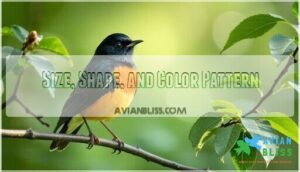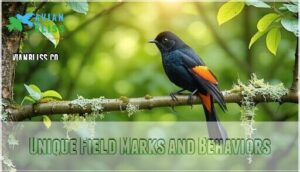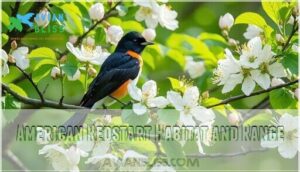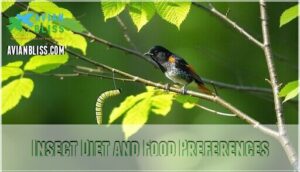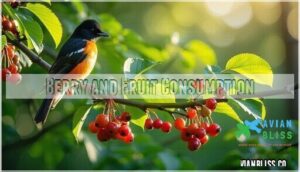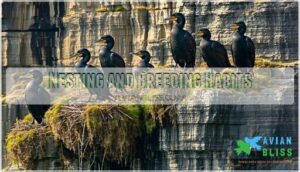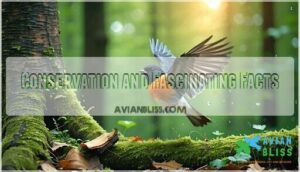This site is supported by our readers. We may earn a commission, at no cost to you, if you purchase through links.

These energetic warblers inhabit deciduous woodlands and forest edges, using their colorful tail feathers to startle insects into flight before catching them mid-air. They combine flycatching with gleaning techniques to hunt caterpillars, moths, and beetles.
American redstarts build neat cup-shaped nests in tree forks and migrate to Central America each winter. Their unique hunting style and distinctive plumage patterns make identification straightforward once you know what signals to watch for.
Table Of Contents
- Key Takeaways
- American Redstart Identification Guide
- American Redstart Habitat and Range
- Feeding and Foraging Behavior
- Nesting and Breeding Habits
- Conservation and Fascinating Facts
- Frequently Asked Questions (FAQs)
- What does a redstart look like?
- Are there redstarts in North America?
- Where did the American redstart come from?
- What kind of bird is a redstart?
- How do you identify an American redstart?
- Are American redstarts monogamous?
- Where can I find redstarts in Washington?
- What is an American redstart?
- Why is it called a redstart?
- Are American Redstarts rare?
- Conclusion
Key Takeaways
- You’ll identify American redstarts by their hyperactive tail-fanning behavior and striking color patterns – males display jet-black plumage with bright orange patches, while females show gray coloring with yellow flash marks.
- You can watch these energetic warblers use their colorful tail feathers as hunting tools, fanning them to startle insects into flight before catching them mid-air in deciduous woodlands and forest edges.
- You’ll find American redstarts build neat cup-shaped nests in tree forks during breeding season, with females handling most parenting duties while some males mate with multiple partners.
- You can attract these notable warblers to your backyard by planting native trees and shrubs in layers, avoiding pesticides to preserve their insect prey, and providing water sources during their migration between North America and Central America.
American Redstart Identification Guide
You’ll recognize an American Redstart by its sparrow-sized body and distinctive color patterns that flash like warning signals as it moves through the trees.
Male redstarts show jet-black plumage with bright orange patches on their wings and tail, while females and young birds display gray coloring with yellow flash marks in the same locations.
Size, Shape, and Color Pattern
You’ll recognize an American Redstart by its sparrow-sized frame and distinctive tail morphology. These warblers showcase striking sexual dimorphism through plumage variation.
Their wide, flat bill shape aids insect catching, while the club-shaped tail creates flash patterns. Size and color pattern make identification straightforward, with orange patches highlighting their unique appearance among woodland birds.
Male, Female, and Immature Differences
Male American Redstarts sport jet-black plumage with bright orange patches on wings, sides, and tail. Females and immature males show gray-brown coloring with yellow flash patterns instead.
This sexual dimorphism helps with age determination during field observations. Young males gradually develop adult plumage through molting patterns, creating identification challenges for birders tracking behavioral differences between sexes.
Unique Field Marks and Behaviors
Watch for these five distinctive behaviors that set American redstarts apart from other warblers:
- Tail Display – They constantly fan and flash their colorful tails like tiny semaphores.
- Active Foraging – Quick darting movements between branches while hunting insects.
- Startle Prey – Wing and tail flashing to flush hidden insects from leaves.
- Insect Catching Tactics – Hovering and flycatching more than typical warblers.
- Defending Territory – Males perform aerial boundary displays with crown feathers raised.
These behaviors, combined with plumage variation between sexes, make identification straightforward once you know what to look for.
Comparison With Similar Species
Similar species cause plumage confusion for American redstart identification. Young males create identification challenges with magnolia warblers due to similar yellow patches. Baltimore Orioles share habitat but are larger with different bills.
| Feature | American Redstart | Similar Warblers |
|---|---|---|
| Size | Sparrow-sized | Varies by species |
| Tail behavior | Active fanning | Less pronounced |
| Flash patterns | Orange/yellow patches | Different placement |
Behavior overlap includes flycatching, but redstarts show more distinctive tail movements than other warblers.
American Redstart Habitat and Range
You’ll find American Redstarts in deciduous woodlands, forest edges, and second-growth areas across eastern North America during breeding season.
These warblers migrate to Central America and the Caribbean for winter, passing through diverse habitats including urban parks and backyard trees with native vegetation.
Preferred Woodlands and Edges
You’ll find American Redstarts thriving in deciduous woodlands where canopy density creates perfect hunting grounds. Edge Effect Impacts create ideal conditions – not too dense, not too open.
These Forest Edge Benefits include abundant insects and understory vegetation needs that native trees provide. Woodland Conservation Efforts focus on preserving these native plants that support their American Redstart Habitat requirements perfectly.
Migration Routes and Seasonal Distribution
American Redstart Migration follows predictable routes twice yearly. These warblers travel from North America breeding grounds to wintering grounds in Central America and the Caribbean.
Migration Timing peaks in May for spring arrivals and August-September departures. Climate Impacts are shifting their routes southward over 310 miles since 1990.
Stopover Ecology relies on woodland corridors for refueling during their extraordinary 2,000-mile journeys. They’re a part of the Parulidae family.
Urban and Backyard Occurrence
During city migration periods, you’ll spot American redstarts in urban habitats like parks and green spaces with mature trees. These backyard sanctuaries become vital stopover sites.
Plant native shrubs and trees to create garden preferences that attract them. Human impact on habitat affects their presence, but bird-friendly backyard tips help.
While feeders don’t attract insectivorous redstarts directly, creating layered vegetation provides the insect-rich environment this bird description requires for successful urban foraging. The species has a moderate concern score of 10/20, assigned by Partners in Flight.
Feeding and Foraging Behavior
You’ll watch American Redstarts use their striking orange and black tail patches as hunting tools, fanning them wide to startle insects from leaves before snatching them mid-air.
American Redstarts use their colorful tail patches like hunting flags, startling hidden insects into flight for easy capture
These active warblers combine flycatching with gleaning techniques, hovering near foliage to pick off caterpillars, moths, and beetles while occasionally eating berries during migration.
Insect Diet and Food Preferences
Once you spot these busy warblers in your woods, you’ll notice their impressive appetite for insects. American Redstart feeding behavior centers on catching live prey with exceptional skill.
Their insect diet includes these primary targets:
- Caterpillars and moths – Large larvae get beaten against branches before eating
- Flying insects – Beetles, flies, midges, and crane flies caught mid-air
- Small arthropods – Aphids, leafhoppers, and daddy longlegs from foliage
- Seasonal diet adaptations – Spring focuses on emerging insects, summer on caterpillars
- Larval diet specialization – Parents feed nestlings soft-bodied insects exclusively
These foraging strategies make redstarts effective pest controllers in forest ecosystems.
Flycatching, Hovering, and Tail Fanning
Watch American Redstarts showcase impressive foraging agility through their signature hunting techniques. You’ll observe them darting from perches for insect capture, hovering beneath leaves, and fanning their distinctive tail displays.
This bird behavior fulfills dual purposes – startling hidden insects and predation avoidance. Their energy expenditure during insect catching appears easy as they spiral upward or make sudden direction changes mid-flight.
Berry and Fruit Consumption
While insects make up their primary diet, American Redstarts also consume berries and fruits during seasonal variation periods. Berry nutrition becomes important when insect availability drops. These dietary supplements support seed dispersal across their range.
Key fruit preferences include:
- Barberry berries during late summer
- Serviceberry fruits in early fall
- Magnolia seeds when available
This dietary impact helps sustain energy during migration periods.
Nesting and Breeding Habits
You’ll find American Redstarts’ breeding behavior both complex and fascinating. Males often mate with multiple females, while females handle most parenting duties.
These warblers build neat cup-shaped nests in tree forks using plant fibers and grass. Females lay 2-5 eggs that hatch after 11-12 days of incubation.
Nest Placement and Construction
Female redstarts choose nest sites carefully, selecting tree forks between 4-70 feet above ground. They build open cup nests using plant fibers, grass, and rootlets as nest materials.
The female undertakes all nest duties alone, weaving these materials into a sturdy structure. She decorates the nest with lichen and birch bark for nest camouflage, creating perfect site selection that blends seamlessly into surrounding foliage.
Egg Laying, Incubation, and Fledging
Redstart reproduction begins when females lay their clutch size of 2-5 eggs. These off-white eggs have brown markings. The incubation period lasts 11-12 days, with females handling all incubation duties. Nestling development occurs rapidly after hatching, and young fledge at just 9 days old.
- Eggs: Off-white with brown or gray speckles for camouflage
- Incubation: Female-only duty lasting 11-12 days consistently
- Nesting: Cowbird parasitism threatens many clutches annually
- Young: Fledge remarkably early at only 9 days old
- Parental Care: Both parents feed nestlings frequently during development
Brood Care, Parasitism, and Mating Systems
American Redstarts break traditional parenting rules in terms of raising young. After fledgling division, males often desert their broods while females shoulder the entire parental care burden. Polygynous males juggle multiple families, with older birds showing greater nesting success. Cowbird parasitism affects up to 50% of nests, creating additional challenges for these determined parents.
| Aspect | Males | Females |
|---|---|---|
| Post-fledging care | Often desert (26% cases) | Care for whole brood |
| Mating strategy | Some polygynous | Usually monogamous |
| Parasitism response | Variable investment | Increased maternal androgens |
| Nesting behavior | Territory defense | Nest construction/incubation |
| Plumage color role | Black/orange attracts mates | Gray/yellow provides camouflage |
Conservation and Fascinating Facts
You’ll discover that American Redstarts face habitat loss from forest fragmentation but remain relatively stable across their range.
These notable warblers use their colorful tail patches to startle insects into flight, making them easier to catch during their acrobatic hunting displays.
Population Trends and Threats
Conservation challenges cast shadows over American Redstarts’ future. Habitat Loss from urbanization threatens breeding grounds, while Climate Change disrupts bird migration patterns.
Population Monitoring reveals 42 million birds face declining trends since 1970. Pesticide use reduces insect prey availability.
Conservation efforts focus on protecting woodland edges and promoting sustainable forestry practices that support these notable warblers.
Adaptations and Unique Behaviors
Several notable adaptations make you notice American Redstarts immediately. Their tail-fanning function startles insects into movement, creating easy catches. Foraging agility lets them twist through branches like aerial dancers. Their plumage startles prey while caterpillar banging breaks down tough meals before swallowing.
- Tail flash magic – Orange and yellow patches create split-second confusion that flushes hidden insects
- Aerial acrobatics – Mid-air pivots and hover-catches that put hummingbirds to shame
- Smart hunting – Banging large caterpillars against branches to disable them before eating
- Mixed mating strategies – Some males juggle multiple families while others focus on single partnerships
Creating Bird-Friendly Habitats
You can create backyard habitats that American Redstarts love. Focus on native plants like serviceberry and magnolia for food sources. Add water features and shelter areas. Stop using pesticides to protect insects they eat. Plant native trees in layers to mimic natural forests. Keep cats indoors and reduce window strikes during nesting season.
| Habitat Feature | What to Provide | Redstart Benefit |
|---|---|---|
| Native Plants | Serviceberry, magnolia trees | Berry food sources |
| Water Sources | Birdbaths, small streams | Drinking, bathing spots |
| Shelter Creation | Dense shrubs, brush piles | Nesting protection |
Frequently Asked Questions (FAQs)
What does a redstart look like?
You’ll spot a redstart by its striking "flash patterns" – males sport jet-black plumage with vibrant orange patches on wings, sides, and tail, while females display soft gray coloring with sunny yellow accents in the same locations.
Are there redstarts in North America?
Yes, you’ll find American Redstarts throughout North America during breeding season. These black-and-orange warblers nest from southern Canada to the eastern United States, then migrate to Central America for winter.
Where did the American redstart come from?
You’ll find this colorful warbler evolved within North America’s diverse forest habitats as part of the Parulidae family.
The genus Setophaga was introduced by the English naturalist William Swainson in 1827, with your redstart as the type species.
What kind of bird is a redstart?
Picture a flash of orange darting through green leaves like a tiny flame. You’re watching a redstart, which is a small warbler in the family Parulidae.
These energetic songbirds belong to the order Passeriformes and display distinctive color patterns that help identify them.
How do you identify an American redstart?
Look for jet-black males with bright orange patches on wings, sides, and tail. Females show gray plumage with yellow flash patterns. Watch for their hyperactive tail-fanning behavior while foraging.
Are American redstarts monogamous?
Like a dance with multiple partners, these warblers don’t stick to one mate. American redstarts practice polygyny, where males often mate with several females during breeding season while raising multiple broods simultaneously.
Where can I find redstarts in Washington?
You’ll spot redstarts in northeastern Washington, especially along rivers in Okanogan, Ferry, Stevens, and Pend Oreille counties. Check forested streamsides with willow-alder thickets.
What is an American redstart?
You’ll find an American redstart is a small warbler with distinctive coloring.
Males show jet-black bodies with bright orange patches on wings and tail. Females display gray plumage with yellow markings instead.
Why is it called a redstart?
Ever wonder why this bird carries such an old-fashioned name? "Start" comes from an Old English word for "tail."
You’ll see males flash vibrant red-orange tail patches, giving this warbler its distinctive name.
Are American Redstarts rare?
No, American Redstarts aren’t rare. Partners in Flight estimates the global breeding population at 42 million individuals and they’re common spring and fall migrants.
This species isn’t considered a conservation priority, with least concern status.
Conclusion
Like a living flame flickering through the forest canopy, the American redstart brings vibrant energy to woodland habitats across North America. You’ve now learned to identify their distinctive tail-fanning behavior, recognize the striking color differences between males and females, and understand their unique flycatching techniques.
Whether you’re spotting them during spring migration or watching their acrobatic insect hunts, these notable warblers offer endless opportunities for observation. Your knowledge of American redstart behavior and identification will augment every birding adventure you take.
- https://www.allaboutbirds.org/news/american-redstarts-can-speed-up-their-migration-but-theres-a-cost/
- https://www.caryinstitute.org/news-insights/feature/climate-change-pushing-american-redstarts-breeding-range-southward
- https://abcbirds.org/bird/american-redstart/
- https://swibirds.org/fff/2018/5/11/american-redstart
- https://pages.vassar.edu/sensoryecology/3464-2/

